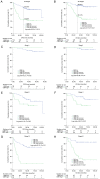Preoperative carcinoembryonic antigen to body mass index ratio contributes to prognosis prediction in colorectal cancer
- PMID: 36245819
- PMCID: PMC9554958
- DOI: 10.3892/ol.2022.13536
Preoperative carcinoembryonic antigen to body mass index ratio contributes to prognosis prediction in colorectal cancer
Abstract
Both carcinoembryonic antigen (CEA) level and body mass index (BMI) are traditional prognostic markers in colorectal cancer (CRC); however, to the best of our knowledge, the value of the CEA to BMI ratio (CBR) has never been addressed. In the present study, 191 patients with CRC treated using radical resection were retrospectively included, and the significance of the CBR in predicting disease-free survival (DFS) or overall survival (OS) rates was calculated. The prognostic efficacy of the CBR in predicting OS was compared with individual CEA and BMI values. The survival differences of the subgroups were calculated by Kaplan-Meier analysis, and corresponding risk factors were then estimated by a Cox proportional hazards model. As a result, 29.84% (57/191) of the patients were assigned to the high CBR group (cut-off, ≥0.28); the CBR had a sensitivity of 56.50 and 68.90%, and a specificity of 80.60 and 80.10% for DFS and OS, respectively. Patients with a high CBR more commonly underwent laparotomy and exhibited advanced T stages, the presence of tumor deposits and advanced Tumor-Node-Metastasis stages (stage II or III). The CBR was more efficient than the CEA or BMI alone in predicting OS. In addition, patients with a high CBR presented with a significantly worse outcome than patients with a low CBR. Finally, the CBR was an independent risk factor for both DFS and OS. In conclusion, the CBR was a more robust prognostic factor in CRC, and patients with a relatively high CBR exhibited poorer survival.
Keywords: body mass index; carcinoembryonic antigen; colorectal cancer; prognosis; ratio; survival.
Copyright: © Xiang et al.
Conflict of interest statement
The authors declare that they have no competing interests.
Figures





Similar articles
-
Preoperative Absolute Lymphocyte Count to Carcinoembryonic Antigen Ratio Is a Superior Predictor of Survival in Stage I to III Colorectal Cancer.Clin Med Insights Oncol. 2022 Sep 26;16:11795549221126249. doi: 10.1177/11795549221126249. eCollection 2022. Clin Med Insights Oncol. 2022. PMID: 36186673 Free PMC article.
-
Preoperative Neutrophil-to-Lymphocyte Ratio, Platelet-to-Lymphocyte Ratio, and CEA as the Potential Prognostic Biomarkers for Colorectal Cancer.Can J Gastroenterol Hepatol. 2022 Jan 4;2022:3109165. doi: 10.1155/2022/3109165. eCollection 2022. Can J Gastroenterol Hepatol. 2022. PMID: 35028301 Free PMC article.
-
Prognostic value of the ratio of carcinoembryonic antigen concentration to maximum tumor diameter in patients with stage II colorectal cancer.J Gastrointest Oncol. 2021 Aug;12(4):1470-1481. doi: 10.21037/jgo-21-61. J Gastrointest Oncol. 2021. PMID: 34532103 Free PMC article.
-
Prognostic Implication of Preoperative Serum Albumin to Carcinoembryonic Antigen Ratio in Colorectal Cancer Patients.Technol Cancer Res Treat. 2022 Jan-Dec;21:15330338221078645. doi: 10.1177/15330338221078645. Technol Cancer Res Treat. 2022. PMID: 35253553 Free PMC article.
-
Prognostic value of preoperative carcinoembryonic antigen/tumor size in rectal cancer.World J Gastroenterol. 2019 Sep 7;25(33):4945-4958. doi: 10.3748/wjg.v25.i33.4945. World J Gastroenterol. 2019. PMID: 31543685 Free PMC article.
References
-
- Takada K, Kashiwagi S, Asano Y, Goto W, Ishihara S, Morisaki T, Shibutani M, Tanaka H, Hirakawa K, Ohira M. Clinical verification of body mass index and tumor immune response in patients with breast cancer receiving preoperative chemotherapy. BMC Cancer. 2021;21:1129. doi: 10.1186/s12885-021-08857-7. - DOI - PMC - PubMed
LinkOut - more resources
Full Text Sources
Research Materials
Miscellaneous
